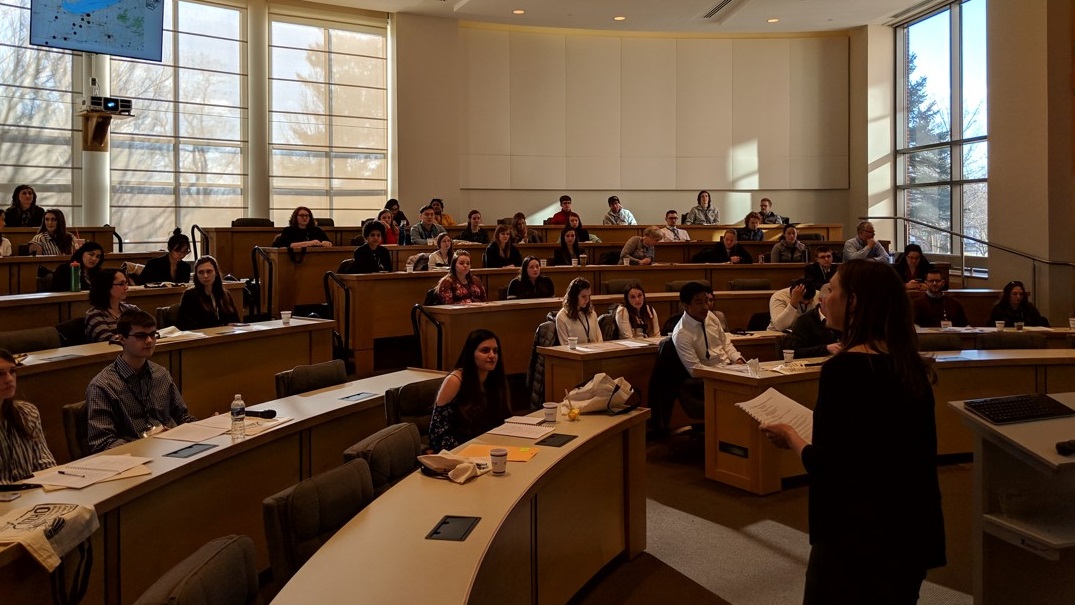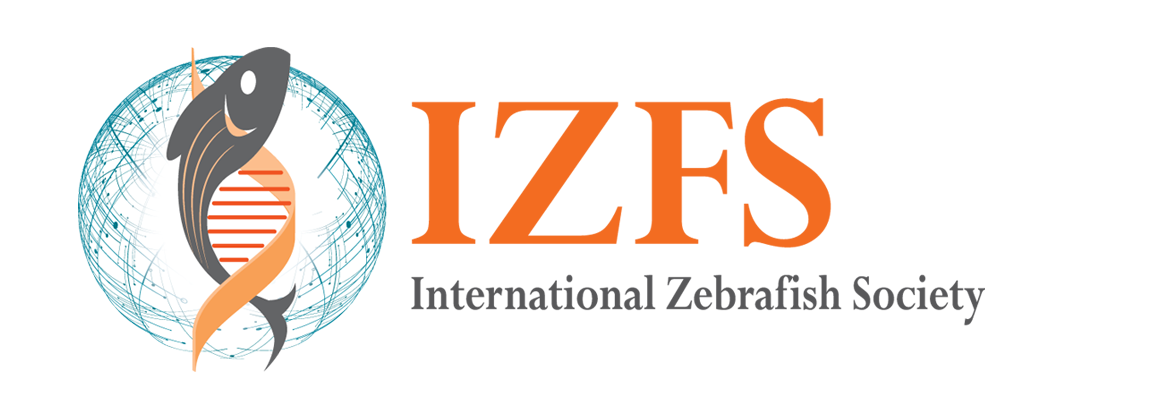2019 Ohio Zebrafish Undergraduate Research Conference Meeting Report
By Anoohya Muppirala
 March 23, 2019 marked the inaugural Ohio Zebrafish Undergraduate (OHZU) Research Conference at Ashland University, Ohio. The OHZU meeting was organized by Dr. Sarah Petersen (Kenyon College), and Dr. Mason Posner (Ashland University), who aimed to create a space to highlight the phenomenal work of undergraduate researchers and create a network of junior scientists throughout the Midwest and beyond. The conference brought together undergraduate zebrafish researchers from fourteen institutions, largely across Ohio but also Michigan, Pennsylvania, and New York. The meeting was held with sponsorship from Charles River Laboratories (Platinum Level), DanioLab (Gold), and Aquaneering (Silver), and PeerJ sponsored the Best Overall Presentation Award, which would cover publication fees for the undergraduate’s project in PeerJ. In addition, sponsoring exhibitors with graduate program representatives came from Case Western Reserve University, Cincinnati Children’s Hospital, Cleveland Clinic, and Ohio State University. The meeting also had generous institutional support from Ashland University and Kenyon College to make this first OHZU meeting accessible to a wide variety of researchers.
March 23, 2019 marked the inaugural Ohio Zebrafish Undergraduate (OHZU) Research Conference at Ashland University, Ohio. The OHZU meeting was organized by Dr. Sarah Petersen (Kenyon College), and Dr. Mason Posner (Ashland University), who aimed to create a space to highlight the phenomenal work of undergraduate researchers and create a network of junior scientists throughout the Midwest and beyond. The conference brought together undergraduate zebrafish researchers from fourteen institutions, largely across Ohio but also Michigan, Pennsylvania, and New York. The meeting was held with sponsorship from Charles River Laboratories (Platinum Level), DanioLab (Gold), and Aquaneering (Silver), and PeerJ sponsored the Best Overall Presentation Award, which would cover publication fees for the undergraduate’s project in PeerJ. In addition, sponsoring exhibitors with graduate program representatives came from Case Western Reserve University, Cincinnati Children’s Hospital, Cleveland Clinic, and Ohio State University. The meeting also had generous institutional support from Ashland University and Kenyon College to make this first OHZU meeting accessible to a wide variety of researchers.
Following the opening remarks from the organizers, Dr. Brian Perkins from the Cleveland Clinic Lerner Research Institute launched the conference with a keynote talk discussing his lab’s use of zebrafish to study retinal degeneration and regeneration. Prior to delving into the science, Perkins framed the conference by quoting Mark Twain, who said, “Do not tell fish stories where the people know you; but particularly, don’t tell them where they know the fish.” Against Twain’s suggestion, Perkins acknowledged that he, as well as the conference attendees, should aim to accomplish the opposite: present interesting research questions to a room full of zebrafish scientists who appreciate the model organism immensely!
In this rebellious spirit, Perkins discussed how he came to use zebrafish. Initially, Perkins had an interest in understanding Inherited Retinal Dystrophies, which are genetic forms of blindness that affect about 1 in 4000 people worldwide. Interestingly, a hallmark feature of these conditions is a loss of photoreceptors in the peripheries of the retina. An important component of retinal development involves proper cilia function, which are motile structures that depend on the movement of motor proteins for intratransport functions. To better understand these intraflagellar transport mechanisms and to link cilia to photoreceptor degeneration, Perkins turned to zebrafish, which are readily accessible for studying the eye. The Perkins lab has exploited the optical transparency of zebrafish with a cone photoreceptor specific GFP transgenic line to characterize a mutant fish line that undergoes slow photoreceptor degeneration but fails to regenerate cones specifically. This led to the understanding that rod progenitors can regenerate new rods, but cones can only be derived from Müller glia. The keynote effectively gave undergraduate researchers a glimpse into the work of the Perkins lab while demonstrating the power of zebrafish as a model organism for understanding cilia transport and retina degeneration and regeneration as they relate to disease pathologies.
The platform sessions included a slate of speakers discussing exclusively undergraduate research. The first session following the keynote was chaired by Anoohya Muppirala (Kenyon College). Emily Teets (Ohio State University) from the Amachar lab described her work investigating the role of the myosin light chain gene mylpfa in fast-twitch muscle function and integrity. mylpfa mutants have aberrant sarcomere structure with improper alignment of actin and myosin along the muscle. For this talk, Emily was the winner of the Best Oral Presentation award. Next, Nicholas Ang (Wayne State University School of Medicine) discussed his work characterizing the function of the Midkine-a protein during retinal and caudal fin regeneration. Mutants demonstrated an inability to regenerate fins properly, and the regenerated region of the fin is oddly shaped with different pigmentation. This led to discussion regarding whether Midkine-A affects proliferation of cells in fin tissue or whether Midkine-A serves as a guidance cue for pigment cells. The third speaker, Charles D. Samuel (Wittenberg University) presented his research on the effects of carbaryl, an insecticide and a global acetylcholinesterase inhibitor, on gene expression in zebrafish. Samuel was exploring a hypothesis from recent studies suggesting carbaryl is a weak aryl hydrocarbon receptor (AhR). Samuel found that one family of genes that are upregulated by carbaryl treatment is cytochrome p450 or “cyp1” genes, which are implicated in the AHR pathway. This discussion transitioned smoothly to the fourth and last speaker for the first platform session, Sarah Porter (Baldwin Wallace University) who described her work investigating CYP1b1 in primary congenital glaucoma.
In the afternoon, Emmaline Kepp (Ashland University) chaired the second platform session, with four speakers investigating different processes in zebrafish. The first speaker, Ethan Bradley (Kenyon College) described a pharmacological screen and proposed mechanism by which small molecules promote peripheral nervous system myelination via the adhesion GPCR Gpr126. Bailey Majtyka (The College at Brockport, SUNY) described his work in the Rich lab studying the role of anoctamin in the regulation of gastrointestinal motility. Returning to the eye, Allessandra Larimer-Picciani (University of Pittsburgh School of Medicine) discussed her investigation into the role of the MITF family genes, which have been identified in human patients who have a malformation of the eye known as coloboma. This condition occurs when there is a failure in fusion of a transient opening in the ventral portion of the eye. MITF genes are highly expressed cranial neural crest cells that populate the eye. Using zebrafish, Larimer and members of the Gross lab are modeling various MITF mutations to see if cranial neural crest cells are affected and perhaps could explain how MITF contributes to ocular and facial malformations. Finally, Hannah Weaver (Case Western Reserve University) closed the session with a discussion of her work from the McDermott lab investigating hearing related channel (Hrc) proteins in stereocilia. Using CRISPR-generated mutants and startle reflex assays, Weaver and colleagues have demonstrated that Hrc proteins are necessary for the startle reflex in larval zebrafish.
Between the platform sessions, students had the opportunity to describe their independent projects in more detail during poster sessions. The zebrafish work overall was primarily centered around development and using the model organism to explore genes and pathways that have also been implicated in human diseases. Similar to the keynote, eye development and retinal regeneration and degeneration were common themes, with posters examining photoreceptor damage and lens development. Additionally, several projects explored candidate genes pertinent to processes in the nervous system, such as myelination, as well as neural differentiation in the enteric nervous system. Various labs also revealed work on optimizing experimental techniques, including phenylthiourea treatment for avoiding pigment formation during development, CRISPR/Cas9 gene editing, and in vivo imaging. Of particular note was the work of Danielle Quallich from the Thummel lab (Wayne State University) investigating regeneration of the retina following light damage. Quallich was the recipient of the Best Poster Presentation award, as well as the PeerJ Award for Best Overall Presentation.
Aside from discussing research, the conference also offered two workshops for faculty and trainee professional development. Faculty attendees participated in a workshop regarding scholarly productivity and work-life balance, led by Mason Posner and Chris Chartier (Ashland University). The facilitators discussed techniques for regularly writing and publishing manuscripts while balancing an undergraduate teaching load. Concurrently, students were invited to attend a workshop led by Sharon Amacher and Amrit Singh (Ohio State University) discussing how to write a successful graduate school application. Both faculty are members of the Ohio State graduate committee. They started the workshop with a brief presentation, then allowed current graduate students and recently accepted undergraduate seniors to answer questions from underclassmen concerning the application process.
Ultimately, the OHZU meeting was centered around showcasing the high-caliber research of undergraduates who are advancing their training in utilizing zebrafish as a powerful model organism to explore a broad range of questions. The research represented at the undergraduate conference was diverse, exemplifying the versatility of using zebrafish as a model organism and the amenability of zebrafish to conduct intensive research at the undergraduate level. In short, the excellent work featured was as relevant and rigorous as that at other conferences, but the OHZU venue allowed undergraduates to discuss ideas and offer advice to near peers. All attendees were united by an appreciation for the accessibility and utility of the zebrafish system, and undergraduates were provided a platform to discuss novel findings across developmental and disease processes.
The next OHZU meeting will take place in spring 2020 at Kenyon College. Zebrafish researchers across institutions, and also outside the Midwest, are warmly invited to participate.
Acknowledgments: The author thanks meeting organizers Sarah Petersen and Mason Posner for assistance preparing this meeting report.




